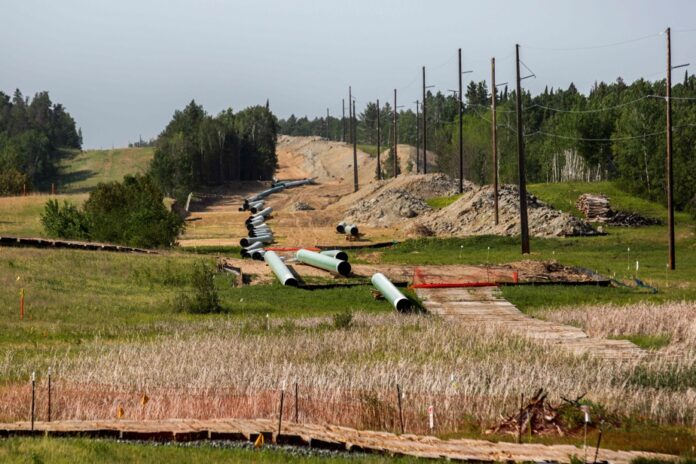(Washington) Severe flooding across the U.S. Midwest has brought the banks of Wisconsin’s Bad River ever closer to Enbridge’s Line 5, amplifying already great fears that the underground pipeline could be dug up and collapse. break into indigenous territories, polluting a vital watershed for the region.
Court documents filed Monday show the Bad River burst its banks twice in the past month, for a total of nine days, washing away up to 2.5 meters of riverbank in some places very close to the underground pipeline.
Late last year, a district court denied motions to immediately stop traffic in the pipeline. Judge William Conley also ordered both parties to submit contingency plans in case the risk of rupture becomes too great.
None of those plans were triggered by the floods this spring, which began on April 11 after a sudden thaw and persisted for days, aggravated by heavy rains. Floodwaters finally receded completely on April 23, the joint report said.
But environmental law body Earthjustice believes the Enbridge pipeline could be “unearthed” with the next major rainfall.
“Line 5 is designed to be underground and not in the rushing waters of a flooded river, where collisions with uprooted trees and other debris could easily cause a leak,” said Timna Axel, spokesperson for ‘Earth justice.
“Line 5 could easily be exposed and rupture unless Enbridge shuts down the pipeline and drains nearly one million gallons [37,000 barrels] of oil flowing between the valves. »
Enbridge, for its part, said in a statement that it “diligently monitors” the pipeline, weather conditions and water levels around the clock, and that if needed, it is “prepared with the necessary plans, procedures, response personnel and equipment”.
Line 5 has undergone multiple due diligence reviews and the U.S. Pipeline and Hazardous Materials Safety Agency “has not raised any safety concerns at this location,” Enbridge added.
The extent of the damage to the banks of the ‘Meander’, where the river and the pipeline are closest, will not be fully confirmed until the Chippewa community and Enbridge are able to get there, as soon as possible, adds the Canadian company .
Environmental concerns surrounding Line 5 have long been a priority in Wisconsin, where the pipeline runs directly through the Chippewa Bad River Reservation, more than 500 square miles of pristine wetlands, streams and wilderness.
Enbridge has already agreed to reroute the work, with plans for more than two years for a 66 km bypass.
Last November, Justice Conley made it clear that he had no interest in ordering an “automatic and permanent closure” of Line 5, citing “widespread economic consequences” and “significant public policy and foreign”.
But the United Nations Permanent Forum on Indigenous Issues, an advisory body to the United Nations, specifically recommended a permanent halt to this pipeline last week, when it closed its last session.
“The Permanent Forum calls on Canada to reconsider its support for the Enbridge pipeline, Line 5, which is jeopardizing the Great Lakes in the United States,” the UN agency said. “The pipeline poses a real and credible threat to the treaty-protected fishing rights of Indigenous peoples in the United States and Canada. »
Line 5 is also the subject of litigation in neighboring Michigan, where the state is asking the courts to permanently close the pipeline over fears of an environmental disaster in the Strait of Mackinac, the environmentally sensitive area where the work passes under the Great Lakes.
Business groups and chambers of commerce on both sides of the border, provincial governments and Ottawa have all rallied behind Enbridge in its efforts to present the survival of Line 5 as an issue critical to continental energy security.
Proponents have argued in court filings as well as in public forums that Line 5 is a vital energy source for several Midwestern states, but also a critical link for Canadian refineries that power some of the busiest airports in the world. Canada.


















